Cremation Ghats in Varanasi: Explore Burning Ghats & Rituals
Varanasi, one of the oldest continually inhabited cities on Earth, holds profound spiritual importance in Hinduism. Situated along the sacred river Ganges, it is revered as the holiest of the seven sacred cities in India. The belief that dying in Varanasi ensures liberation from the cycle of rebirth, or Moksha, draws thousands of pilgrims each year seeking spiritual release. here are some of details about Cremation Ghats in Varanasi.
Suggested Read: 9 Important Ghats in Varanasi out of Total Ghats in Varanasi India
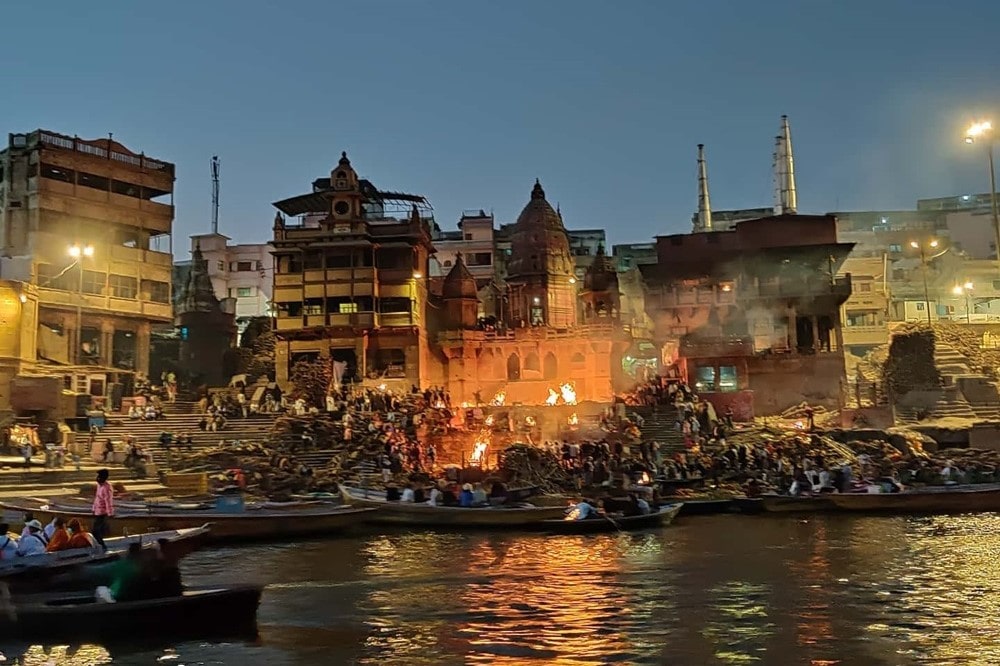
Manikarnika Ghat
Central to this belief is Manikarnika Ghat, the largest and most sacred cremation site in Varanasi. Here, the eternal flame has been burning for centuries, fueling the pyres on which nearly 100 bodies are cremated daily. The ghat functions day and night, symbolizing the unceasing cycle of life and death.
It’s said that being cremated here, with one’s ashes scattered in the purifying waters of the Ganges, guarantees liberation from reincarnation and the attainment of Nirvana. Cremation Ghats in Varanasi
The atmosphere of Varanasi might seem overwhelming to some, especially as funeral processions wind their way through the narrow streets towards the ghats. Cremation Ghats in Varanasi
For many elderly individuals, the city’s boarding homes serve as their final resting place, as they await death in the hope of a sacred cremation. Cremation Ghats in Varanasi
These homes are often filled with those who, lacking family, spend their last days begging to save enough money for their funeral. Cremation Ghats in Varanasi
Suggested Read: A Day Trip of Sarnath from Varanasi: How to Reach | What see

Burning Ghats Varanasi
Overview: Cremation Ghats in Varanasi
Yet, Varanasi is not merely about death. The city pulses with life, devotion, and celebrations. It is filled with temples, daily rituals, and offerings to Lord Shiva, the city’s patron deity. Visitors are not only witnesses to death but also to the vibrancy of life and the faith that pervades the city’s streets and ghats.
Watching the daily Ganga Aarti ceremony or experiencing a boat ride at dusk, with the burning pyres in the distance, offers a unique perspective on life and death, deeply rooted in Hindu philosophy.
For many, Varanasi represents the cyclical nature of existence—a place where death is not an end but a transformative step towards spiritual liberation. Cremation Ghats in Varanasi
In Varanasi, life and death coexist in an extraordinary way along the ghats. The city’s Manikarnika Ghat is one of two primary cremation sites, and it offers a stark view of the Hindu rituals surrounding death and the afterlife.
Thousands of Hindus travel to Varanasi every year, hoping to die there to escape the cycle of rebirth and achieve moksha, the ultimate liberation.
Cremations in Varanasi at the burning ghats of Varanasi are among the most profound rituals in Hinduism, a city renowned for its spiritual significance and the sacred Ganges river. These cremation rituals, particularly at Manikarnika Ghat, the main burning ghat, attract pilgrims from across India who seek to free their loved ones from the cycle of rebirth.
Suggested Read: Varanasi Kashi Benares, are the same city in India ?
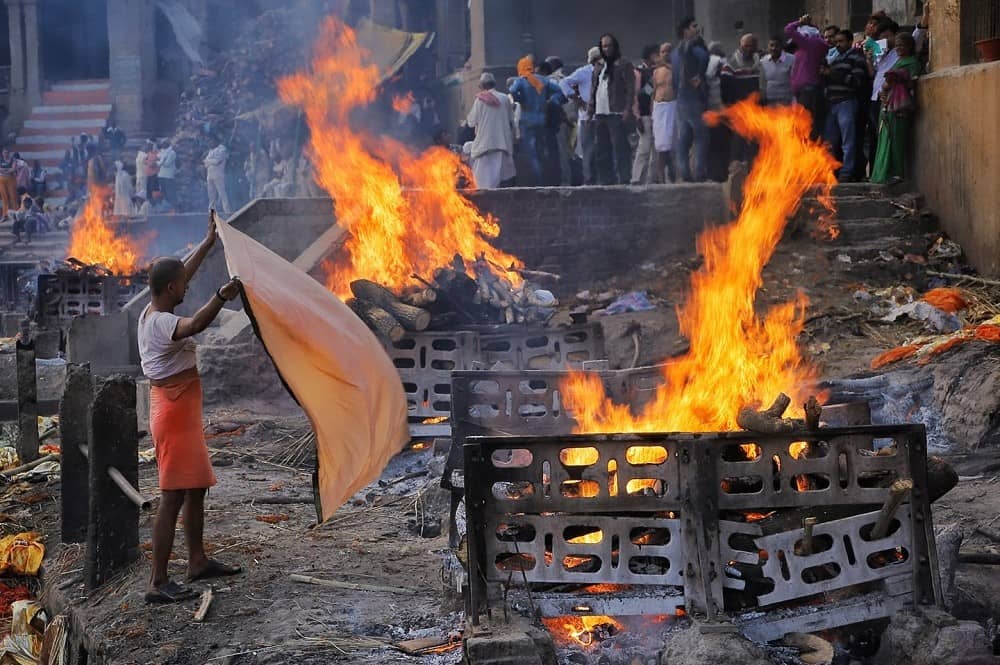
Harishchandra Ghat Varanasi
Varanasi Cremation Process
Upon arrival at the ghat, bodies are first wrapped in cloth and adorned with flowers. They are placed on a bamboo stretcher and taken to the river to be washed. This washing ritual purifies the body before cremation. The body is then laid upon a wood pyre, ready to be lit.
A close male relative, usually dressed in white and having shaved his head, takes part in the ritual. He collects a flame from the eternal fire, which has been burning continuously for centuries, to ignite the funeral pyre.
Circling the pyre and reciting prayers, the relative lights the wood, beginning the cremation process. The entire process is overseen by workers, often from the “untouchable” caste, who assist in ensuring the pyres burn properly.
The cremation requires a large amount of wood, and some families, particularly the poor, may struggle to afford enough, leaving behind larger bones after the burning. However, donations often help these families, and sandalwood is added to mask any unpleasant odors, resulting in a surprisingly neutral scent, even when close to the burning pyres.
Sacred Exceptions
Not all are cremated. Children, pregnant women, Saddhus (holy men), and those with leprosy are exempt from cremation, as they are already considered pure. Instead, their bodies are tied to large stones and submerged in the middle of the river. Cremation Ghats in Varanasi
Photography and Etiquette
Photography at the burning ghats is typically forbidden out of respect for the grieving families. Some visitors, with the help of local guides like Raj, can obtain unofficial permission, often early in the morning or late at night. However, obtaining official documents for photography is costly and time-consuming. Regardless, respect for the families is paramount.
Best Time to Visit
Cremations at the burning ghats happen 24/7, every day of the year. However, the ideal time to visit Varanasi is after the monsoon season ends, around late October, when the river levels are lower, revealing more of the ghats for cremation rituals. The weather cools around this time, though air quality may decline due to seasonal agricultural burning. Cremation Ghats in Varanasi
Varanasi’s burning ghats offer a powerful glimpse into Hindu beliefs about life, death, and spiritual liberation. For many, witnessing these rituals provides a unique understanding of the sacred cycle of life and death central to Hinduism.
Varanasi’s ghats, 88 in total, are steps that lead directly to the sacred Ganges River. Most of these ghats are used for daily rituals like bathing and prayer, but a few, like Manikarnika and Harishchandra Ghats, are reserved for cremations. The constant smoke rising from the burning pyres creates an atmosphere of reverence and solemnity, even as life bustles around the ghats.
My Experience
As bodies arrive for cremation, they are wrapped in cloth, often white muslin, and adorned with flowers, especially orange marigolds. The head of the deceased remains uncovered, providing a final glimpse before cremation begins.
The family cleans the body, and the male relatives carry it through the streets to the ghat while chanting, marking the last journey of their loved one.
The body is placed on a pyre made from wood, which is meticulously prepared. The eldest male relative, after shaving his head as part of a purification ritual, lights the pyre with a flame taken from the eternal fire at the ghat. The cremation is intensely physical and symbolic.
As the fire consumes the body, relatives and onlookers witness the transition of the soul. Once the body is reduced to ashes, the remains are scattered into the Ganges, where the cycle of life is believed to end.
However, not everyone is cremated. Sadhus, pregnant women, children, lepers, and victims of cobra bites are considered pure and are instead released directly into the Ganges, bypassing the need for cremation.
Despite the omnipresence of death at the ghats, Varanasi is a city teeming with life. The streets echo with the sounds of daily life—prayers, horns, conversations—and the spiritual energy in the air is palpable.
This coexistence of life and death is a reminder that for the people of Varanasi, death is not an end but a continuation of the spiritual journey. The cremations at the burning ghats are a unique reflection of the city’s deeply spiritual soul, where both mourning and celebration of life intermingle.
Cremation Ghats in Varanasi Cremation Ghats in Varanasi Cremation Ghats in Varanasi Cremation Ghats in Varanasi Cremation Ghats in Varanasi Cremation Ghats in Varanasi Cremation Ghats in Varanasi Cremation Ghats in Varanasi


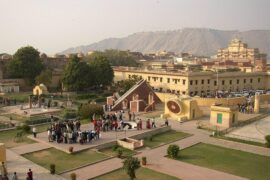
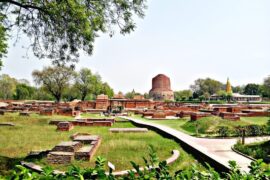
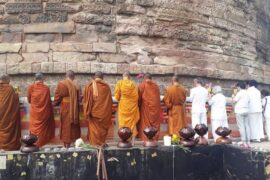
Comments are closed.